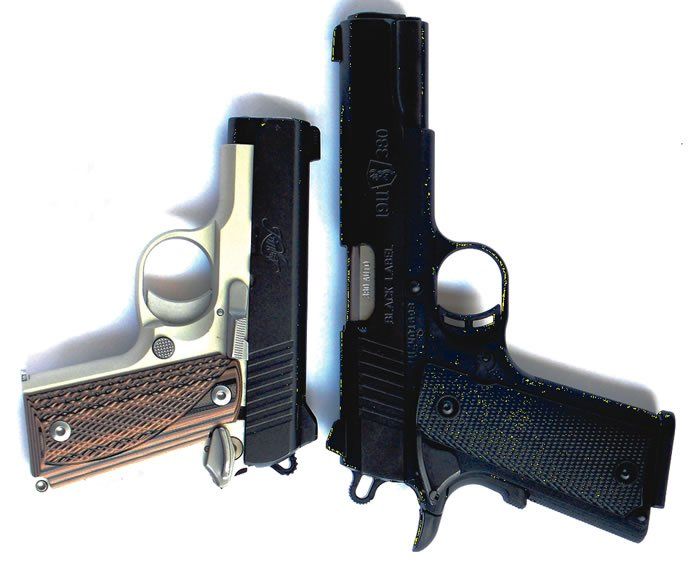
John Browning’s 1911 handgun design has been produced the world over in some of the finest factories in the world, as well as some copies beat out on a rock in Afghanistan. Some 1911s have been downsized — in what they shoot — to a variety of cartridges smaller than 45 ACP, such as 40 S&W, 38 Super, 9mm Luger, and 22 LR, to name just a few. The handguns reviewed here, the Browning 1911-380 and the Kimber Micro Carry Advocate, are likewise downsized in cartridge to the 380 ACP (aka the 9mm Kurz, or 9mm Short), and they are physically downsized as well. This has been done before in the form of several variations by Colt, the Mustang being among the best known. Older raters fondly remember the Star 380 ACP handguns that were available in both service-size and micro-size variants. Going further back, the Colt 1903 Pocket Hammerless that preceded the 1911 was a compact 32 ACP pistol that saw action all over the world. It was also chambered for the 380 ACP in later variations. The popularity of the 380 ACP round is certainly a result of its easy shooting characteristics, made even easier in the larger variants with bigger grips and more weight.
The 1911 market is huge, as is the 380 ACP market, but there are only a relative handful of firearms that combine the ergonomics of the former and the soft recoil of the latter. In particular, Browning and Kimber are not willing to leave the 380 ACP market to Colt and SIG, so they have attempted to marry the big gun’s controls with the pocket pistol’s shootability in their respective handguns, the 1911-380 and the Micro Carry Advocate. Each rides on the coattails of the full-size 1911; however, only the Browning is a true miniaturized 1911. We call the Kimber “1911-like.”
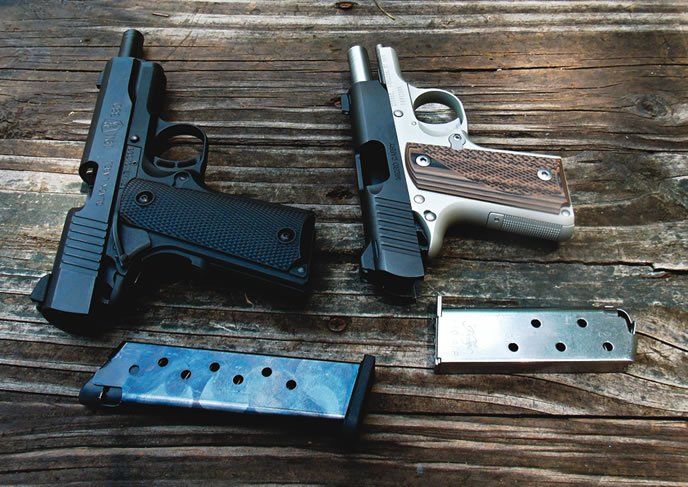
In this test, our shooters found out that both sidearms work well, and that the Kimber is a very good pocket pistol to boot. The Browning will not fit in an average pocket, and that makes its place in the scheme of personal-defense carry guns problematic. Here are more of our insights on these two handguns:
Browning Black Label 1911-380051904492, $620
This was the listed price one of Browning’s preferred online dealers, AbleAmmo.com, advertised. GunsAmerica.com had it selling for $599. BassPro.com had it in stock for $600. TallTalesOutdoors.com had it listed for $560, but the 1911-380 wasn’t in stock.
The 1911-380 is advertised as an 85%-size 1911. The dimensions bear this out. The advantage of the 1911-380, Browning claims, is that despite its small size, the pistol is functionally a true 1911. Like many full-size 1911 handguns, the 1911-380 features extended controls for comfort and rapid manipulation. The first thing our shooters noticed is that the pistol fit our hands well, in particular, the frame doesn’t cramp average-sized hands. The grip safety, a true beavertail safety with memory bump, is a nice update to the standard 1911-type grip safety. In fact, we think that the grip safety of the 1911-380 might be more useful in preventing hammer bite on such a small handgun than with the larger 45-caliber versions. A raised section at the bottom of the grip safety is intended to provide better hand fit. Those using a thumbs-forward grip may not always depress the grip safety properly, as this grip style sometimes raises the palm off of the grip safety. This raised section is an advantage for most shooters, we’ve found. Even so, some of the shooters missed activating the grip safety during the firing tests, despite this bump. A grip safety properly disengages the trigger at about half of the grip safety’s travel into the frame. We think the Browning disengaged a bit past the halfway mark, and the shooter must acclimate to this idiosyncrasy.
We were pleased to see an ambidextrous slide-lock safety. This safety offers true right- or left-hand combat capability. The left-handed shooter must have the ambidextrous safety, while those wishing to use the handgun with either hand also need this safety.
The frame was a lightweight material that Browning calls “black composite,” and it seemed to us to be a mix of aluminum and polymer. The front of the grip frame was molded checkering, which we liked a lot. The mainspring housing was designed to give the shooter a good grip during shooting. The magazine used a steel body. Capacity was eight rounds. A single magazine was supplied with the pistol, which we thought was ridiculous. Two with the gun is reasonable, but three is a realistic minimum for all-round utility.
At more than 4 inches in length, the barrel was long for a compact 380 ACP pistol. But as you can see in the chronograph tables, the Browning delivered higher velocities than the Kimber. The advantage was 66 fps with the Fiocchi loading and 84 fps with the Hornady load, which we feel is significant. We will take all of the energy we can get in a short-9mm handgun. The muzzle was finished with a recessed barrel crown.
The action is described as locked breech. We cannot disagree; however, it isn’t a locked breech identical to the full-size 1911. The ramped barrel doesn’t use a swinging link, but rather the angled camming surfaces of the Browning Hi-Power. When the pistol fires, the slide recoils but a fraction before continuing without the barrel, making it, perhaps, the shortest locked breech ever. However, the slide was easy to rack — unlike a blowback action that demands a heavier spring — and the barrel was easily removable, although tighter in the slide than most 1911s. The recoil spring guide was a piece of white plastic. The recoil spring plug was also plastic. The pistol field-strips as a standard, full-size 1911 does.
Before we began shooting, we lubricated the pistol along the bearing surfaces and around the barrel hood, as well as the barrel portion that contacts the barrel bushing. During dry-fire familiarization, the trigger reset announced itself with a pronounced click. The trigger action was smooth, breaking at 6 pounds even. Reset was rapid.
We began our familiarization with Black Hills Ammunition 100-grain FMJ loads, which was slowed somewhat because we only had one magazine. As advertised, it held eight rounds. With the slide locked to the rear, we inserted the magazine and released the slide to feed the first cartridge. The pistol came out of the box running. During the firing of 60 rounds of the Black Hills FMJ load, there were no failures to feed, chamber, fire or eject. The pistol proved fast on target. Drawn from a Barber Leatherworks Chameleon, the Browning came on target quickly and responded well to a trained shooter. For a pistol this size, the combat-style sights offered an adequate sight picture and proved capable during accuracy testing.
We fired combat groups at 5 and 7 yards with good results. It wasn’t difficult to keep a full magazine in the K-zone of a man-sized target at 15 yards. In combat firing at close range, our shooters noted the Browning was easy to control and comfortable. The pistol gets high marks in that regard. However, on at least three occasions, the raters jerked a shot wide on the target because the grip safety wasn’t fully depressed.
Firing for accuracy off the benchrest, we used three different 380 ACP loads. These included the Black Hills 100-grain FMJs, Fiocchi 90-grain XTPs, and the Hornady 90-grain Critical Defense loads. Groups were fired at 15 yards rather than the customary 25 yards due to the small size of the handguns. The Browning delivered adequate accuracy, but the pistol was difficult to handle consistently due to its small size and small sights. Groups ranged from 3 to 4.5 inches, with the smallest groups fired coming after we were familiarized with the Browning’s firing characteristics. The best group of the day was a 3.1-inch effort with the Fiocchi 90-grain XTP. Clearly, the Browning was accurate enough for home defense or personal defense at limited range, but in our tests, the smaller Kimber pistol was more accurate in bench rest fire.
Our Team Said: The Browning 1911-380 is a pistol that will appeal to the 1911 fan as a novelty, a neat 85% scale 1911. For those interested in its suitability for personal defense, the Browning fits in the same niche as the Walther PP, the Astra A60, and the Beretta 84, among others. It is an easy handgun to use well and was accurate enough. However, the 1911-380 is nearly as heavy as many compact 9mm handguns and was not considered to be a pocket gun by our shooters.
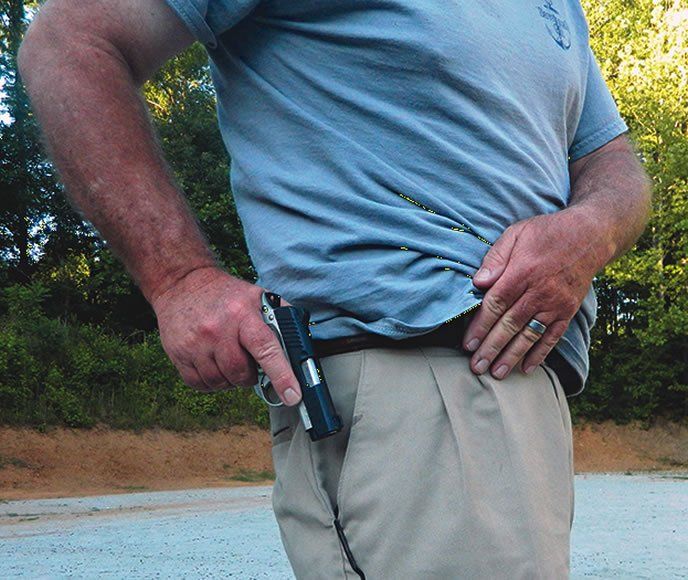
Kimber Micro Carry Advocate Brown 380 ACP, $700
OsageCountyGuns.com listed this at $699. GunsInternational.com had it for $700. Cabelas.com listed it for $800. The Kimber is a much different handgun than the Browning, and not solely as a result of dimension. The pistol isn’t as close to the 1911 template as the Browning. Close enough for intuitive handling if you are familiar with the 1911, but the details differ greatly. These differences may be a deal breaker in either direction. If you do not like the 1911 grip safety, the Kimber is your choice.
Elsewhere, the Kimber we tested was well made and finished, with a blue-steel slide and anodized-aluminum frame. The checkered wooden grips were very attractive. The Kimber was supplied in a padded case with a spare 7-round magazine with finger extension, but the magazine we used for our measurements was a 6-round design.
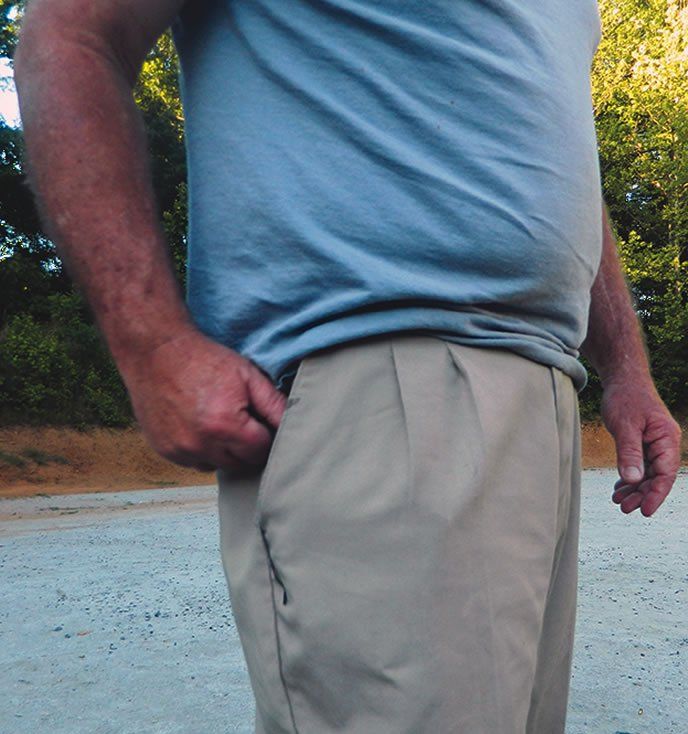
The sights were good combat sights equal to the Browning. The Kimber, however, featured three-dot sights with tritium inserts, a big advantage on a personal defense pistol. In common with the Browning, the Kimber uses the internal extractor common to other 1911 handguns. However, the Kimber does not use a grip safety. In this design, with a pistol bordering on tiny, a grip safety would have been difficult to incorporate into the design. As we discovered, the grip safety wasn’t ideal when used in the Browning. The frame of the Kimber extended in a generous beavertail tang that aided in comfortable firing. The hammer of the Kimber rides deeper in the slide than the Browning, which will be a good thing if shooters opt to carry the pistol with the hammer down while in the pocket.
The pistol disassembled much the same as any other 1911, except that the pistol featured a metal one-piece guide rod and wound recoil spring. The Kimber also uses the angled camming surfaces of the Browning type instead of the 1911 swinging link. When the pistol is disassembled, there is a loaded spring under the slide stop to maintain pressure on the stop. Reassembly isn’t difficult, but attention must be paid to the small wire ejector, which must be depressed.
There was no magazine safety, which the Browning does incorporate. Few American-designed pistols use the magazine safety, and no service pistol that we are aware of in use in this country still uses a magazine safety. The Kimber featured a positive firing pin block. The slide-lock safety, well, isn’t a slide-lock safety. The thumb safety does not lock the slide. This allows loading the pistol with the safety on. On this subject, we found the safety to be a positive. While carrying the pistol cocked and locked in the pocket, the safety never rode off its indent. Just the same, the raters reached a consensus that each would probably carry the pistol in the pocket hammer down. In a proper, well-made pocket holster, cocked and locked is viable, and every pocket pistol should be carried in a holster. The safety may be applied with the hammer down, which doesn’t have much value. Do not move the safely to the on position with the slide off the frame, or the safety may fall out of the frame.
A feature of the Kimber we did not like was the heavy trigger. The trigger operated with minimal take-up followed by firm consistent pressure, but it broke at 8.75 pounds when the company claims it should be set to 7.0 pounds. Just the same, we did great shooting with the pistol.
To get started, we lubricated the Kimber and then loaded both magazines with Black Hills Ammunition 100-grain ball ammo. We concentrated on the magazine without the finger rest during control testing, as this is the magazine we think most shooters will be carrying in the pistol to get the smallest size possible.
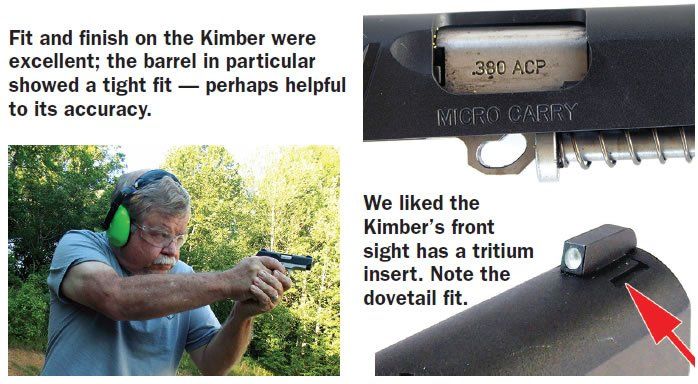
The advantage in control, if any, was slight with the larger magazine. By the same token, the extra height did not seem to adversely affect concealed carry. The Kimber proved tractable and gave good results in short-range drills. Despite the shorter grip and sight radius, the Kimber demonstrated groups superior to the Browning’s. When firing off the bench for best accuracy, the heavy trigger was more of a challenge than in combat shooting. All raters commented that the pistol was as easy to fire quickly and to keep on target as the Browning, probably because of the light recoil of the 380 ACP cartridge. There is usually a penalty in felt recoil when moving to a small frame, as is very true when considering the 40 S&W or 45 ACP compact pistols. With the 380, each pistol was easy to use well; the larger gun just kicked even less. When firing the first few groups, we registered a number of 4- and 5-inch groups at 15 yards, definitely in the pocket-pistol class of not-so-hot accuracy. Finally, after some effort, we were able to print a number of groups in the 3-inch class. The best group came with the Hornady 90-grain FTX, which shot a 2.5-inch cluster at 15 yards.
We reran our results, because it was counter-intuitive that the larger gun wasn’t as accurate as the smaller gun. We fired the remaining JHP loads and 40 rounds of the Black Hills ball in each handgun on the combat course, running the guns in tandem rather than in separate testing. The Kimber outpaced the Browning again.
Our Team Said: The Browning offered another round in magazine capacity, an ambidextrous safety, and greater energy due to higher velocity. However, the Kimber exhibited groups at least as good as the Browning in combat firing and better accuracy off the bench. The Kimber costs more dollars, somewhere between $80 and $100, probably, depending on where you shop. Part of the cost is seen in the Advocate’s superior fit and finish, tritium sights, and a spare magazine. For us, the Kimber was the better pistol, and it would have earned an A grade except for its too-heavy trigger.
Written and photographed by R.K. Campbell, using evaluations from Gun Tests team testers. GT




























